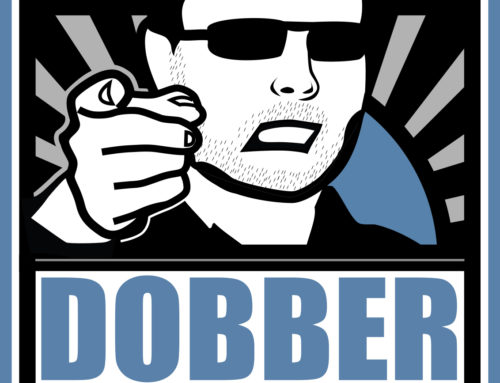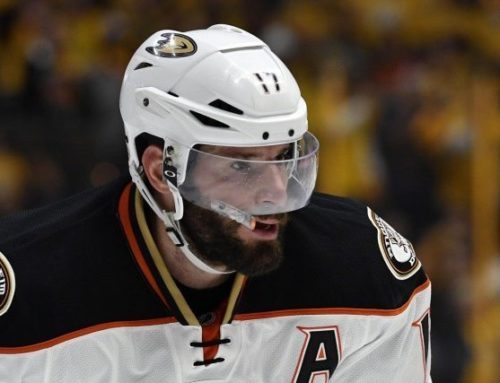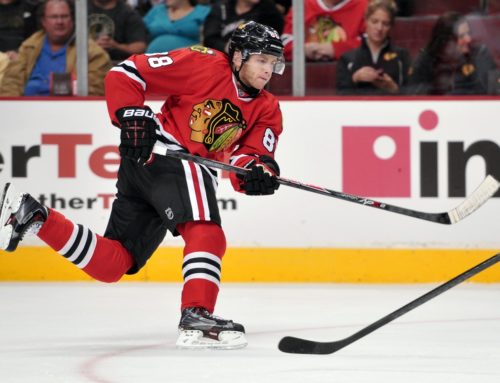Active and Passive Goaltending
Justin Goldman
2010-03-29

Before every NHL regular season comes to an end, I like to reflect on the progression of goaltending from a league wide perspective, as compared to this point last year. It's a good way to formulate a solid scope of what we might expect in the playoffs, while also taking a snapshot of the goaltending position, one that constantly evolves.
I think the most visible trend that influenced the position in the last year has been the traffic and bodies around and in the crease area. This was accentuated by the Olympics, as the return of the non-truncated crease proved that current NHL creases play a role in the proximity of bodies to the net and their ability to distract goalies more than usual. A body crashing the net has been a running trend all season long and it has increased since the Olympics ended.
But there's another trend that has really stood out in my mind since October. That would be the shift from passive butterfly goaltending to a more active, reactive and athletic style of goaltending.
Below I will not only break down the differences between the two "styles" but also explain why it is important that these two styles coexist together within a goalie's game. But first, let me preclude the breakdown with a couple of disclaimers, so that there's no confusion surrounding this week's adequately complicated subject.
First of all, the words active and passive are not catch-all words. They're only intended to describe the style seen in a myriad of different situations in a game. A goalie might have an active style one moment and play passive the next. It might flip back and forth from period-to-period or game-to-game. Or there's even the chance a goalie's style never changes. As such, the terms should only indicate one or two plays. Every goalie could be either style at any time.
Secondly, active and passive are personal terms I use to describe goaltending in the manners you see below. This in the same manner I've been analyzing goalies since the beginning. Other goalie coaches and analysts may or may not use these terms the same way, as slightly varying definitions will exist. But most of the time, you'll have no trouble correlating them to one another. So there's many ways to get the same kind of message across and this one is mine!
ACTIVE GOALTENDING STYLE
Active goaltending can be described in simple terms as going out and meeting pucks in an effort to take away time, space and net from the shooter. Active goaltending is often seen in smaller, more reactive goalies. They rely on quick and sharp hand and foot work to make big saves on rebounds or second and third chances.
Active goaltending includes an active stick. Goalies will use it to cut off passing lanes from behind the net or along the goal line, make the occasional poke check on a breakaway or a play from the corner and handle the puck often.
Active goaltending includes active hands. Goalies will hold their gloves well out in front of their bodies, which not only allows them to take away more space, but move with a little more freedom.
Active goaltending includes active feet. Goalies will actually kick or direct pucks to the corners when making toe and leg saves. The gloves and stick will also follow the legs in an attempt to get more blocking surface behind the shot.
A few goaltenders that fall in the active style category, more than most others, would be Pekka Rinne, Tuukka Rask, Tomas Vokoun and Marty Turco. They all use quick and active feet and hands to make a number of big saves.
PASSIVE GOALTENDING STYLE
Passive goaltending can be described in simple terms as being as minimalistic and positional as possible so that pucks hit you and are absorbed as much as possible. Passive or "calm" butterfly goaltending is often seen in much bigger and less-mobile goalies. They rely on size and stature in the net to create a wall that takes up more space and forces shooters to pick the corners.
Passive goaltending includes a passive stick. Goalies will focus more on making sure the stick is always covering the five-hole and will rarely be used to poke check, so that they never commit to a play and lose that coverage.
Passive goaltending includes more relaxed hands. Goalies will keep their gloves attached to the top of their pads and focus more on sealing the holes between both elbows and sides of the body.
Passive goaltending includes much quieter feet. There is less foot movement involved because it is not as quick, but travels a further distance due to the bigger size. Passive goalies often have slightly wider stances because their size compensates for the need of faster movements.
A few goaltenders that fall in the passive style category, more than most others, would be Niklas Backstrom, Carey Price and Cam Ward. They rely more on solid positioning and bigger bodies to force pucks to hit them.
COEXISTING STYLES
When it comes to deciding which style is better, you'll find that there's no definitive answer. Sometimes it's better to be passive, other times it's better to be active. As a result, goalies at the pro level strive to have a good combination of both. They will focus more on the decision-making process between the two, depending on the situation at hand, as opposed to the execution of the actual save.
A successful pro goalie will know when to use each style and how to do so in a manner that effectively helps them manage a game. This is important when looking at fantasy prospects, because having this ability is a sign a goalie has strong situational awareness. And we all know how vital that term is to a goalie's success!
That being said, when is it better to be passive and when is it better to be active? Which one has more advantages?
One reason why I feel active style is more advantageous right now in the NHL is because of how it makes handling rebounds caused by traffic or deflections. If a passive goalie sits back and makes a save but gives up a rebound, he may not have the foot speed or the ability to shift and transition weight quickly enough to get behind that second shot. An active goaltender, however, will already be well on his way through the transition process when the puck comes off his pads. Odds are good that he'll either get a toe, a shoulder, an elbow or a stick on the rebound shot.
There are many reasons why both active and passive styles are advantageous. But ultimately, it comes down to personal philosophy. Either a goalie likes to go out and get the puck, or they like being in position for shots to just hit them. But the important thing to remember as a fantasy manager is that goalies need to be confident with both styles.
So when it comes to dissecting the present in hopes of understanding the future, I'll leave you with one final thought.
There's a visible shift from passive to active goaltending this year, as reflected by the strong play of smaller goalies. This shift has caused the bigger goalies to start incorporating more of an active style into their game. They challenge shooters more by moving out to take away space.
To me, this is all the proof I need to know that being an assertive goalie has some clear-cut advantages over sitting back and playing a passive style. As discussed above, there are times when being passive is more effective, but it seems like those moments are slowly dwindling as time goes on.





 BUF
BUF N.J
N.J PHI
PHI MIN
MIN VAN
VAN FLA
FLA TOR
TOR CGY
CGY DAL
DAL